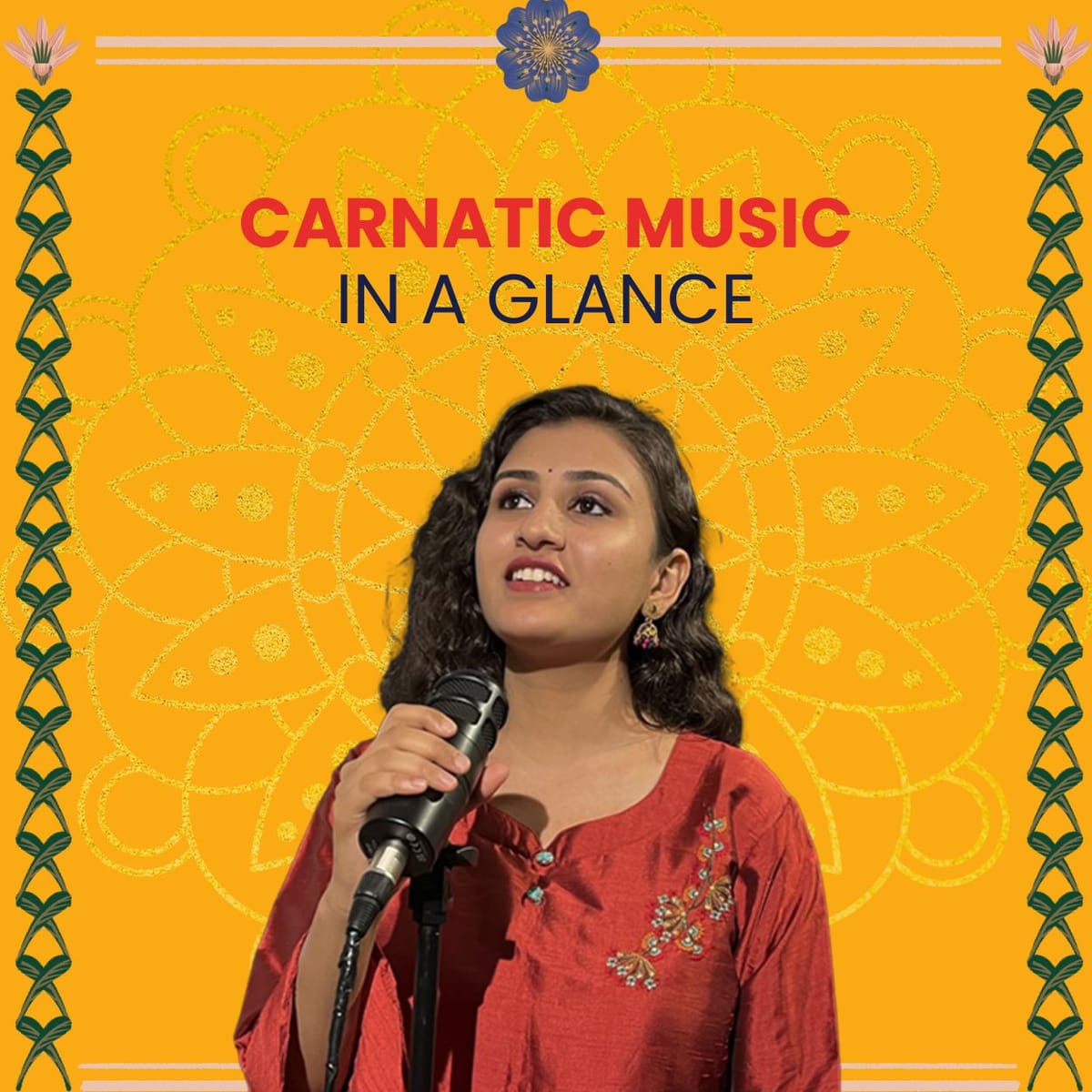
Carnatic Music In A Glance


Learning music is very similar to learning a new language, starting with the alphabet, then words, and sentences. There is a wide variety of musical genres including Carnatic Music, Hindustani Music, Western Music and so on. And Hans Christian Anderson’s inspirational words apply to all kinds of music -
“Where words fail, Music speaks”.
So, where does Carnatic Music fit into this? To understand that, let’s first understand what Carnatic Music is.
1. What is Carnatic Music?
Carnatic music, commonly known as Classical Music is a colorful and complete form of Indian Classical Music with origins in Southern India. Carnatic music owes its name to the Sanskrit term Karnātaka Sangītam which denotes “traditional” or “codified” music.
Carnatic music follows a fixed structure which applies to the learning process as well. We start with learning the sruthi(pitch), swaras(letters), swarasthanas(positions of the swaras), then ragas(tunes), talam (rhythm) and finally, it turns into a beautiful song.
Carnatic music is one of the world's oldest & richest musical traditions with 7 fundamental swaras, 16 swarasthanas, 72 basic scales on the octave, and a rich variety of melodic motion.
Carnatic music is one of the two main subdivisions of Indian Music rooted in the ancient Hindu texts and traditions, particularly Samaveda. This is why Carnatic music has such a rich cultural heritage.
The other subdivision is Hindustani Music with origins in Northern India.
Carnatic Music combines melody, rhythm and lyrics. The main emphasis in Carnatic Music is on Vocals. Most compositions are written to be sung, and even when played on instruments, they are meant to be performed in Gayaki (singing) style. The majority of compositions are on the theme of devotion, love towards divinity. A few instruments are also used as the accompaniment, such as Tanpura for sruthi, Mridanga, ghatam for rhythm, violin and a few instruments like Morsing, Veena and Flute.
2. Why Carnatic Music?
Carnatic music demands attention so much that the listener is truly immersed in the song. This immersion is very close to meditation and thus provides the positive benefits of calming the mind.
Carnatic music follows a directness of the expression and the range of melodic material available is highly diverse. A song can be performed simply and in all humility, or with the grandest elaboration retaining the core of both meaning and melody.
While learning Carnatic music, you not only learn the rich musical tradition but also gain an understanding of the Indian cultural heritage. You learn to sing and easily identify the ragas of the song in your Carnatic music classes and in addition, it also helps you improve your concentration level, create a great personality, develop patience, and remove negative thoughts from the mind.
The success of music is ultimately in the mind of the listener, and specifically in the physical and emotional changes which can be provoked. It is a simple fact that Carnatic music has only a positive effect in this way, while the same cannot be said for various forms of popular music. This is because Carnatic music demands attention so much that the listener is truly immersed in the song. This immersion is very close to meditation and thus provides the positive benefits of calming the mind.
Both the ability of music to build and release tension as well as its potential to unlock latent energies in the mind are respected and developed. And of course. the meaning of the lyrics revolves around acts of religious devotion which also adds to the feeling of sublimity.
Carnatic music is usually performed by a small group of musicians who sit on an elevated stage. This usually consists of, at least, a principal performer (usually the vocalist), a melodic accompaniment, a rhythm accompaniment, and a drone.
Carnatic music is usually learned through many compositions. Telugu language predominates in the evolution of Carnatic music. Most Carnatic compositions are in Telugu and Sanskrit along with some in Tamil and Kannada.
3. How does Carnatic Music differ from Hindustani Music?
There are many similarities between Carnatic and Hindustani music since they have both evolved out of Indian Classical Music.
But there are also several differences that distinguish the two styles. The two styles differ in instruments, structure, swarasthanas, ragas, vocal usage, language and approach to improvisation.
Given below are the very basic differences between Carnatic and Hindustani Music.
Carnatic Music VS Hindustani Music

4. Some of the popular Carnatic compositions by different composers
Mahaganapathim in raga Nattai
Devadeva Kalayaamithe in raga Mayamalavagoula
Vathapi Ganapathim Bhaje in raga Hamsadwani
Samajavara gamana in raga Hindolam
Carnatic music is one of the world's greatest treasures and the journey of learning Carnatic music will take one to a different peaceful world.